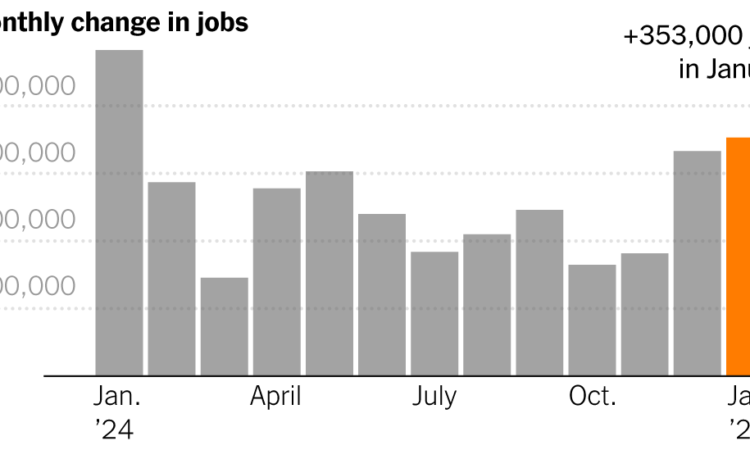
The United States delivered a much-bigger-than-expected batch of jobs last month, adding further evidence that the economy still has plenty of steam.
Employers added 353,000 jobs in January, the Labor Department reported on Friday, and the unemployment rate remained at 3.7 percent.
After the loss of 14 percent of the nation’s jobs early in the Covid-19 pandemic, the labor market’s endurance for more than three years has surprised economists, who expected factors including the Federal Reserve’s interest rate increases to slow hiring more sharply. The strong data on Friday is likely to reinforce the Fed’s patience in beginning to cut rates.
“There’s layoffs happening, but workers are able to find new positions,” said Sara Rutledge, an independent economics consultant. “It’s almost like a ‘pinch me’ scenario.”
Ms. Rutledge helped tabulate the National Association for Business Economics’ latest member survey, which found increasing optimism that the country would avoid a recession — matching a turnaround in measures of consumer confidence as inflation has eased.
The growth in January was all the more impressive on top of upward revisions to the prior two months, which brought the monthly average job gain in 2023 to 255,000. Professional and business services accelerated to pile on 74,000 jobs, while health care added 70,000. The only major sector to lose jobs was mining and logging.
The bumper crop of added jobs, nearly twice what forecasters had expected, mirrors the similarly surprising strength in gross domestic product measurements for the fourth quarter of 2023.
Average hourly earnings also grew swiftly, at 0.6 percent from December, although that may have to do with a shortening of the workweek and the addition of so many white-collar workers, who tend to make more money. Hotels and restaurants, where pay is lower, shed a few thousand jobs.
Agron Nicaj, a U.S. economist at the banking and financial services firm MUFG, noted that job postings had been elevated in professional and business services for the past few months. That may mean January’s surge will be short-lived.
“I wouldn’t expect a reacceleration because of the relationship with the industries that grew this month and the openings,” Mr. Nicaj said. “I think this month reflects a refilling of jobs that they couldn’t fill.”
The new year dawned on what has been an exceptionally good economy for many workers, with the number of open jobs still exceeding the stock of people looking for positions, even as new immigrants and women have joined or rejoined the work force in unexpected numbers. Wages have been growing faster than their historical rates, and a strong increase in productivity has helped keep those fatter paychecks from fueling price increases.
Over the past year, most gains have been powered by sectors that either took longer to recover from the pandemic — including hotels, restaurants and local governments — or have outsize momentum because of structural factors, like aging demographics and pent-up demand for housing.
Other categories that experienced supersize growth during 2021 and 2022, including transportation, warehousing and information technology, have been falling back to their prepandemic trends. Another handful of sectors, such as retail, have been largely flat.
Despite the prominent announcements of layoffs at firms like UPS, Google and Microsoft, across the economy employers have been loath to part with workers, worried about being short-staffed if business picks up again.
In the coming months, economists had expected the labor market to become even more like its prepandemic self, without the giant job growth that followed the pandemic lockdowns. The latest numbers may call that assessment into question.
Even manufacturing, which has been in a mild recession for about a year, added 23,000 positions. That reflects optimism in the latest purchasing managers index for manufacturing, which jumped unexpectedly last month. Timothy Fiore, the chair of the Institute for Supply Management committee that oversees the survey, said it seemed like the beginning of a turnaround, even if a slow one.
“Now we’re starting to gain altitude,” Mr. Fiore said. “It’s not a fighter pilot gain; it’s a cargo plane gain.”






